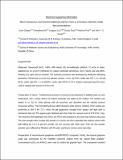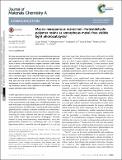Files in this item
Macro-mesoporous resorcinol-formaldehyde polymer resins as amorphous metal-free visible light photocatalysts
Item metadata
| dc.contributor.author | Zhang, Guan | |
| dc.contributor.author | Ni, Chengsheng | |
| dc.contributor.author | Liu, Lingjuan | |
| dc.contributor.author | Zhao, Guixia | |
| dc.contributor.author | Fina, Federica | |
| dc.contributor.author | Irvine, John Thomas Sirr | |
| dc.date.accessioned | 2015-11-13T13:10:04Z | |
| dc.date.available | 2015-11-13T13:10:04Z | |
| dc.date.issued | 2015-08-14 | |
| dc.identifier | 204125976 | |
| dc.identifier | b085cd77-883d-4bfa-92b2-27fe4398fa72 | |
| dc.identifier | 84937406155 | |
| dc.identifier | 000358211700008 | |
| dc.identifier.citation | Zhang , G , Ni , C , Liu , L , Zhao , G , Fina , F & Irvine , J T S 2015 , ' Macro-mesoporous resorcinol-formaldehyde polymer resins as amorphous metal-free visible light photocatalysts ' , Journal of Materials Chemistry A , vol. 3 , no. 30 , pp. 15413-15419 . https://doi.org/10.1039/C5TA03628C | en |
| dc.identifier.issn | 2050-7488 | |
| dc.identifier.other | ORCID: /0000-0003-2594-350X/work/31348246 | |
| dc.identifier.other | ORCID: /0000-0002-8394-3359/work/68280606 | |
| dc.identifier.uri | https://hdl.handle.net/10023/7781 | |
| dc.description | The authors thank the Engineering and Physical Sciences Research Council (EPSRC) for funding (EP/K036769/1; EP/K022237/1) and Royal society for a Wolfson Merit Award(JI). | en |
| dc.description.abstract | We have demonstrated that resorcinol–formaldehyde resin polymers are good visible light responsive photocatalysts, with band gap energies ranging from ca. 1.80 to 2.00 eV. They were found to be photoactive in terms of decomposition of organic substrates under visible light irradiation. The photocatalytic performance of resins could be markedly enhanced by coupling with electron conducting materials such as reduced graphene oxide. Photocatalytic water oxidation was also achievable on the hybrid reduced graphene oxide/resin catalyst with a sacrificial agent. These industrial widely-used resins exhibit many merits as photocatalysts such as low-cost, high surface area, large pore size and volume, facile preparation and scalability for development of eco-friendly commercial products with “self-cleaning” properties, based on their capability for the oxidative removal of organic pollutants under visible light. | |
| dc.format.extent | 2828805 | |
| dc.format.extent | 628204 | |
| dc.language.iso | eng | |
| dc.relation.ispartof | Journal of Materials Chemistry A | en |
| dc.subject | QD Chemistry | en |
| dc.subject | NDAS | en |
| dc.subject.lcc | QD | en |
| dc.title | Macro-mesoporous resorcinol-formaldehyde polymer resins as amorphous metal-free visible light photocatalysts | en |
| dc.type | Journal article | en |
| dc.contributor.sponsor | EPSRC | en |
| dc.contributor.sponsor | The Royal Society | en |
| dc.contributor.sponsor | EPSRC | en |
| dc.contributor.institution | University of St Andrews. School of Chemistry | en |
| dc.contributor.institution | University of St Andrews. EaSTCHEM | en |
| dc.identifier.doi | 10.1039/C5TA03628C | |
| dc.description.status | Peer reviewed | en |
| dc.identifier.url | http://www.rsc.org/suppdata/c5/ta/c5ta03628c/c5ta03628c1.pdf | en |
| dc.identifier.grantnumber | EP/K022237/1 | en |
| dc.identifier.grantnumber | WRMA 2012/R2 | en |
| dc.identifier.grantnumber | EP/K036769/1 | en |
This item appears in the following Collection(s)
Items in the St Andrews Research Repository are protected by copyright, with all rights reserved, unless otherwise indicated.


